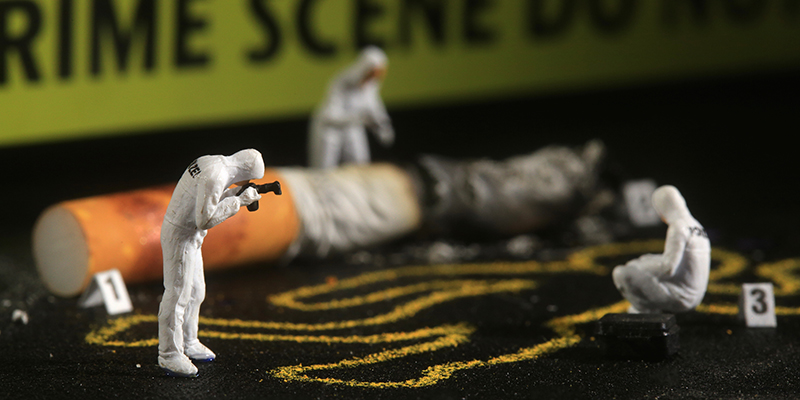My current series revolves around the Locard Institute, its forensic science focus made of equal parts research, training, and private investigation for clients who need/can afford it.
The Locard does not exist, alas. I invented and designed it for flexibility in plotting—but CSI schools are real enough. As labs are accredited and techs are certified, a certain amount of continuing education credits are required to maintain those standings. Forensic training classes might last from a morning to a week. Students include cops, fingerprint analysts, drug lab techs or death investigators with experience anywhere from a few months to a few decades.
Most any professional employee would find the idea familiar. Doctors travel to learn new surgical techniques. Civil engineers practice laying out a planned community. Personnel from Personnel must keep up on EEOC-compliant employee application forms. Supply managers must learn how to do inventory via a tablet app.
The process is also familiar. Training flyers arrive at your work email or your boss leaves one on your desk. The HR department has to give you the okay to travel, pay the tuition and make you sign three forms in order to be trusted with the company credit card—after first giving you the sharpest of looks, as if it’s her personal financial future at stake if you return without an itemized receipt from McDonald’s.
Where CSI schools differ is in the subject matter. And the execution.
In Basic Bloodstain Pattern Interpretation we spent days experimenting with horse blood (donated by living horses) by dripping it from pipettes while walking, while running. We soaked sponges in it, covered the walls and floor with reams of brown paper, and hit the sponges with hammers, baseball bats and latex-enclosed fists. We hung the sponges downfield and shot them. We soaked weapons and tools in it and swung them around. Sure, all that could have been explained in a PowerPoint presentation, but would we have retained it? And would a slide show have been as much fun?
(Funny story: Of course, classroom instruction doesn’t always translate to reality, just as that supply manager might find the handy tablet app is not so handy when on a loading dock in a snowstorm while wearing heavy gloves. In the Basic Bloodstain class we worked with paper covered walls and the floor—flat surfaces at a ninety-degree angle. In the Advanced class, they might throw in a small end table. Wall, floor, table. Flat, level surfaces. At this point I was technically a bloodstain pattern expert so when we had a brutal stabbing inside a garage, my boss called me in to do my stuff. I burst onto the scene with enthusiasm—and stopped. The garage was half storage facility and half man cave, with a flat screen, couch, coffee table, fan, gun safe, tool bench, tool cabinet along the walls and the entire center filled waist-high with an impassable mountain of boxes, empty luggage, old bikes, pool toys, lawn care equipment, and who knows what else because we saw no reason to excavate down to the box of P90X DVDs. Blood covered a good portion of the floor, but thrashing had shoved the couch and the table and the flat-screen so that I didn’t know if the patterns had been deposited before or after movement, skewing angle determination. I turned to my boss. “Where’s my wall, floor, table? I could do that!”)
At a ‘buried body’ class we examined (happily, didn’t have to exhume it, since it was there for the semester-long community college class) the grave of a small pig. The college teacher had placed it on a small island in the middle of a campus pond, to keep the odor from disturbing the students studying less smelly things like accounting or computer science. I can’t say I learned a lot about how to conceal a clandestine grave because a few of us spent the time instead observing a fish make a nest in the surrounding waters. It would scoop up sand in its mouth, take it to the edge of its crater, and spit it over the berm, creating a perfectly round circle. Sorry, but this model of determination was a little more interesting than the migration pattern of maggots.
In Crime Scene Reconstruction, we used colored string to lay a grid along a section of lawn and here’s-the-gas-line-don’t-dig flags to mark where tossed bullet casings lay. (Again, didn’t work quite so well in a house that qualified for an episode of Hoarders where the ground is anything but level.)
We also observed qualified personnel fire bullets into vehicles to demonstrate how to tell the bullet’s direction of travel. Picture an oval swimming pool with a zero-entry slope at one end. That will be the bullet’s first contact with the vehicle. The other end, where the metal is a little bunched up into a hole, is where the bullet finally built up enough metal to deflect it into puncturing the door or roof or hood. Cracks in the windows will crater, with the larger diameter on the exit side of the glass. In regular window glass, cracks will form in spider-legs, emanating outward in a line from the hole, but will also form in concentric circles around the hole. If you examine the edge of the broken pieces you can tell which side of the glass the bullet entered from the stress marks. But if two shots are close enough together for their cracks to intersect, you can tell which came first—cracks will end in existing cracks. If the lines from hole B end in lines from hole A, B came first.
Meanwhile, back at where the shooter is standing, casings fly from his automatic pistol and scatter, bounce and roll across the sidewalk. They do not land in the same place. In other words, in those episodes of CSI where they calculate exactly where the casing went as it was ejected from the gun is so much applesauce.
Sometimes, our courses are purely classroom instruction. I recently spent two days listening to FBI latent print examiners go over the current thinking in how to word court testimony explaining fingerprint analysis, identifications, and eliminations. You may have heard rumblings in the past dozen years about how fingerprints ‘don’t work any more’ or ‘have no basis in science’ and so on. That is more of that applesauce, but, there is a very real need to standardize how it is documented, supported, and explained to a jury. The Organization of Scientific Area Committees for Forensic Science, begun by DOJ and now administered by NIST, is attempting to do just that, not only for fingerprints but for all forensic disciplines. They create a set of standards for training examiners, for quality control, for writing reports, for testimony, and then publish the drafts so anyone who wants to, such as me, can submit questions or suggestions for improvement, which they will consider and perhaps implement. Then they will send out another draft, and the refining continues. The process is necessary, wonderful, intelligent, responsible and democratic…and glacially slow.
Technology, of course, changes daily and at an ever increasing pace. I just spent three days at work learning how to use a new alternate light source. It looks like a small tablet with a big ole camera lens attached, and that’s pretty much what it is. Except the camera also has a light source that can deliver wavelengths from bright white to the ROYGBIV stuff to ultraviolet to infrared. And has built-in filters in the necessary colors to enhance or block the wavelengths as necessary. And has a camera that can capture the resulting surface image and offload same via USB or Bluetooth. And has preset programs that have made it largely idiot-proof. Are you looking for blood on a purple sweater? It will give you the five top combinations of light and filter with a touch of a fingertip. Searching for gunshot residue on a multicolored backpack? Tap, tap, and click. I can’t describe what a wonder this thing is, especially for someone like me who has never been able to really comprehend light theory or remember what color filter goes with what wavelength and why. Sometimes the stuff you see on CSI isn’t really applesauce.
So, yes, CSIs really go to school, and quite often. That part of the Locard Insitute series isn’t fiction. Walk into any forensic continuing ed class as the attendees will span all ages, genders, races and locations. Some people might be there because they needs the CEUs, or because they’re newbies to the field and need all the stuff they didn’t get in college. Sometimes they’ve been in the field for years but recently had other duties added to their lab. Sometimes they just want to get out of town for a week on their agency’s dime.
But what would happen, I asked myself, if one of them moonlighted as a serial killer? Could they resist the temptation to ply their trade in the midst of those trained to catch serial killers? Could any psychopath resist that challenge?
The answer, as you’ll see, is no.
***


















